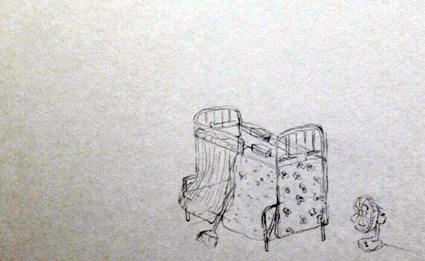FP member Kelvin Lam’s “castle on rainy days” and Jess Lau’s “pirates’ boat,” “extreme environments” and “ET arriving” mark many HK children’s fantasy play with space or the lack of it. To reproduce these childhood experiences in FP WIP opening 20 Nov 2016, what are they going to show us?
[English translation after Chinese texts. Please scroll down.]
當 Floating Projects Collective 說要辦一個玩具展時,我和林建才想共同創作一件作品。我們開始討論印象裡最深刻的玩具,發現我們最喜歡的玩具都是自己「發明」的,當年的玩具的樣貌、遊戲規則都記得非常清楚。可能因為小時候總沒有耐性,新買回來的玩具很快就生厭,所以每當大人不在家的時候都會非常興奮 - 終於可以把家裡的東西變做自己的玩具或遊戲哩。
林建才曾經畫過一幅畫,記他小時候每逢下雨天就會把自己藏在椅子下,再用「咕臣」把椅腳的四邊圍起來,做一個下雨天的城堡 - 只有自己和雨聲的城堡。如果表兄妹來訪時,一人就會佔據一張椅子建做自己的城堡,再投擲紙球互相「攻打」。
 Jess Lau’s “pirate’s boa” in thunderstorms … 劉清華的「海盜船」在黑夜狂風中潛行
Jess Lau’s “pirate’s boa” in thunderstorms … 劉清華的「海盜船」在黑夜狂風中潛行
而我,最記得的就是將碌架床的下格當成一艘船,掃把是船槳,遊戲設定是在逃亡,要把必需品帶上船然後過著海盜的生活。遊戲裡的夜晚或狂風暴雨,就是把上格床的被子掛下來,開著電風扇,然後我和弟弟就會相當配合地搖來搖去。記得母親相當討厭這件「玩具」,因為我們總是玩得太累忘記將那些「必需品」還回原位,所以,後來的遊戲設定是要在母親從超級市場回來之前將一切還原,假裝我們只看了閃電傳真機。
除了海盜船,我還有極地遊戲 - 就是打開雪櫃,坐在前面吃麵包和鑽木(地板)取火。外星人遊戲,就把燈關掉,窗簾拉下,然後在電風扇前面說話,聲音變調後自己就是外星人。
現在想起來這些遊戲都是小時候對空間的渴求和想像。林建才又說,簡單的玩意,像將一塊木頭繫上繩子,就可以拖著走,像在劃分自己的「國土」。可惜,現在這些遊戲都不湊效了,他已經太大個子塞不進椅子底下,而我的單人床上若坐了兩個成年人大概轉身也非常困難。又其實,我們現在已經覺得這些玩具不好玩,但心底裡對空間的渴望和想像好像沒有太大改變。我們今天的「下雨天的城堡」,就是一間閒時會漏水的工作室,又或幾趟有趣的外遊旅程。
**劉清華和林建才的《玩具再做》,將於11月20日據點打開門的「玩具作為媒體」中與訪者見面。
Project title: 玩具再做
Artist statement: 「二十年後我們畫下小時候曾為自己做過的玩具。」
When the idea of having a toy show came through at Floating Projects, Kelvin Lam and I immediately thought of a work to make together. We started talking about the most favorite toys we had as a kid, and realized that they were also toys we “invented.” Even the look of our toys, details and the rules that went with them are still vivid in my mind as if they are right here with us. Probably as kids we were quite impatient with playing with the same toy again and again. Because of that, adults’ brief absence from home made our day – we would then freely turn objects in the household into our toys, or to use them in our playing.
Kelvin once did a drawing to preserve the memory of a favorite toy of his. As he recalls, on rainy days he often hid himself under a chair and block the four sides of the chair with cushions. That was his fortress on a rainy day, in which he dwells safely, shutting everything off except himself and the sound of the rain. On occasions when his cousins were visiting, they would each occupy a chair to “built” their own fortress, from which they would start throwing paper balls to “attack” each other.
As for me, my best memory goes to a double-deck bungle bed I shared with my brother, which I turned into a “pirates’ ship.” The lower deck would be our main cabin; a broom became our oar. The default dramatic situation was an escape: to run for life, we had to bring all kinds of basic necessities to live the life of a pirate. At “night,” there would be gales and thunderstorms. We would then took the sheets and blankets from the upper deck and hang them around the “lower deck” and turned on an electric fan. My brother and I would then rock the boat (bed) in a coordinated rhythm. I remember Mom really hated our “toy” because we, totally exhausted towards the end of the game, seldom returned our “daily necessities” to where they were. Soon, we decided that our game would have to finish and everything returned to the right place before Mom returned from the supermarket, pretending that we just finished a children’s program on TV.
The refrigerator was my other “toy.” In the “extreme environment” situation I set up, I opened the fridge and sat in front of it to eat bread and to make fire (on the floor). As for my encounter with the ETs, I would turn off all the lights, blinds drawn down, and spoke in front of a fan. With a trembling voice, I became an ET.
Now looking back, we realize our invented toys and games were all about spatial imagination, and very much an expression of our desire for the space that we did not have. Kelvin also mentioned a very simple game that was also about making space: he would tie a rope around a piece of wood and drag it along as he walked, as if he was marking his territories. It’s a pity that these games and toys would not satisfy us any more. Kelvin the adult has outsized the space under a chair, and for my bungle bed, there is barely enough space for two adults to next to each other by the bedside. But then we don’t find these toys fun any more. What remains unchanged is our desire for space. Right now, our “fortress on a rainy day” has transformed into our art studio, a flat in an old building in Wanchai in which rain causes leaks here and there. As for journeying, it is lucky of us that we have managed to make a few real overseas tours.
Jess Lau and Kelvin Lam’s project title: “Toys Remade”
Artist’s statement:
“20 years have gone by… we are making sketches from memory of the toys we made as kids.”
 Kelvin Lam’s childhood invention, “castle on rainy days” 林建才小時候的「下雨天的城堡」
Kelvin Lam’s childhood invention, “castle on rainy days” 林建才小時候的「下雨天的城堡」
RELATED READINGS:
Toys as Medium: Artistic Passion, Self Expression & Circuits of Cultural Artifacts
Long Time No See: TAMIYA-Tiger 1



